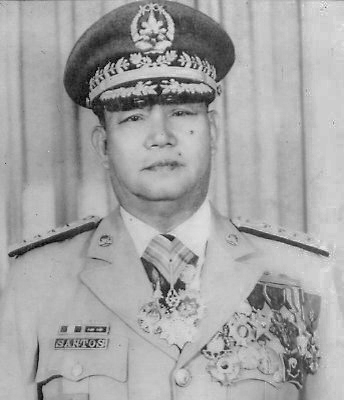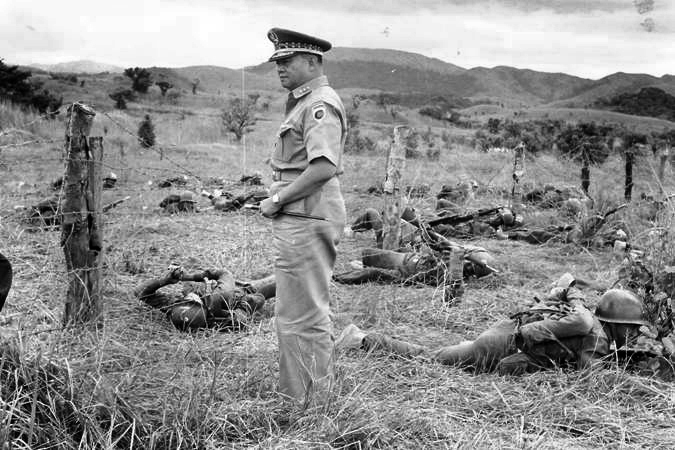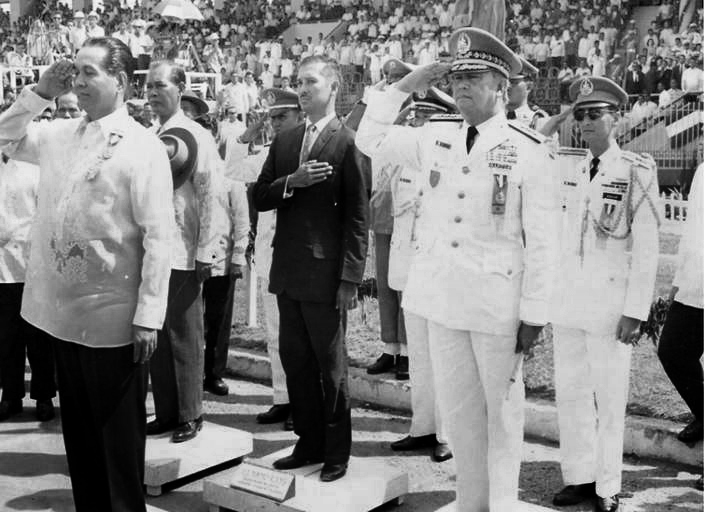<Back to Index>
- Philosopher Hans Blumenberg, 1920
- Painter Sebastian Stoskopff, 1597
- General of the Philippine Army Alfredo M. Santos, 1905
PAGE SPONSOR


General Alfredo M. Santos (July 13, 1905 – February 7, 1990) was Chief of Staff of the Armed Forces of the Philippines in 1962 to 1965, making him the first four - star general of the Philippines' armed forces.
Engineer turned soldier, General Alfredo M. Santos is one of the most notable "Freedom Fighters" of the Philippines with a heroic war record. His outstanding achievements proved his selfless dedication to the service of his country and people, thereby bringing distinct honor to the Armed Forces of the Philippines. He is well known for his physical and moral courage, and keen sense of fairness, justice, honesty and integrity. He championed the cause of the deserving and competent reserved officers and integrees in their relentless struggle to gain meritorious recognition and achieve further competence in military service.
Alfredo
M. Santos was born in Santa Cruz, Manila, Philippines, on July 13, 1905
to Fructoso L. Santos and Agatona J. Manapat, and was seventh among
fourteen children. His secondary education was acquired in Manila North
High school (now Arellano). He graduated at Mapúa Institute of Technology with
a degree in Bachelor of Science in Civil Engineering in 1931. He showed
interest in the military when he graduated on the top of his ROTC class in 1929. As a cadet colonel and Corp Commander in both institutions, he continued this interest after schooling. General
Santos' military career started when he was appointed probationary
Third Lieutenant on June 8, 1936, after five years of civil engineering
practice. He entered the Reserve Officer Service School (ROSS) at Camp
Henry T. Allen in Baguio City, where he was made the Battalion
Commander. He graduated at the top of his class, and twenty years
after, he was honored as its Most Distinguished Alumnus. Then Captain Santos was the most decorated Unit Commander of the 1st Regular Division in the memorable Bataan campaign, even dubbed by Commanding General, Brigadier General Fidel V. Segundo, as the "Hammer of the Division" when
he brilliantly outmaneuvered and outsmarted the enemy during their
attempt to pocket their area. In both attempts, his unit successfully
broke through the Gogo - Cotar and Tuol Pockets, thus earning for
himself
the moniker "hero of the pockets" For
his heroic feat in battle, he was promoted to Major in the field. Two
days after, he was decorated with the United States Army's Distinguished Service Cross for
"extraordinary heroism in combat in Bataan" and the Silver Star for
"gallantry in action". Later, the Philippine Government awarded him the
equivalent Distinguished Conduct Star and Gold Cross for the same
combat action. On
January 25, 1942, a superior Japanese Army force launched a determined
and relentless attack southward from a general line along Pilar - Bagac
Road. This attack swept the outpost line in resistance, and penetrated
the Main Line of Resistance (MLR) of the 1st Regular Division on the Gogo - Cotar River area, Bataan,
creating a 500 yard gap through which the enemy rushed. For four days,
hundreds of death defying enemy troops tried to puncture and overwhelm
the lines. Major
Santos was given the hazardous mission of closing the gaps and
annihilating the enemy troops who had infiltrated the lines as the gap
posed a serious threat to the positions and the security of the
division. With utter disregard for his personal safety, he led a
counter attack against the strong and numerically superior Japanese
forces positioned between the MLR and
the Regimental Reserve Line (RRL). The fighting began at dawn of
January 29, 1942. With dogged determination, the defenders fought
assiduously and without pause against all odds to restore the defensive
sector assigned to the 1st Regular Division. Major
Santos was ordered to surrender his unit to the Imperial Japanese
Forces which he reluctantly did on April 12, 1942. He shared in the
sufferings of those in the "Death March" to Camp O'Donnell at Capas, Tarlac, where he became a prisoner of war. He was released from the concentration camp on August 10, 1942. The cessation of the hostilities between the Japanese invaders and the USAFFE forces
did not stifle his fighting spirit and love for freedom. During the
Japanese occupation from December 1942 to January 1945, he joined the
Filipino - American Irregular Troops (FAIT) under Col. Hugh I. Straughn
as Chief of the Intelligence Division of the North Section in Manila,
with the rank of Colonel. He fought with the American and Filipino
soldiers in the liberation of Manila from February to March 1945. He
returned to military control at the end of the liberation campaign that
year and was assigned at Camp Murphy as Camp Inspector of the 2nd Camp
Complement. Later, he held other positions of major responsibility,
including Executive Officer and S-3 of the 1st Camp Complement; Acting
District Commander at Camp Olivas, San Fernando, Pampanga; Commanding
Officer of the 4th MP Battalion, Mandaluyong, Rizal, in April 1946; and
Executive Officer of the Presidential Guard Battalion in Malacañang Palace, Manila. In July 1946, he was sent to the United States as a student officer at the Command and General Staff College at Fort Leavenworth, Kansas, USA, where he finished the regular Command and Staff course a year later on July 3, 1947. When
Congressman Datu Mangelen and Senator Salipada Pendatun offered him the
provincial governorship of Cotabato in 1951, through then Secretary of
National Defense Ramon Magsaysay,
he declined. It was a personal decision which was very difficult to
make. At that time, the position was appointive, rather than elective. The province of Cotabato then
was in turmoil. Violent clashes occurred, resulting in the death of
many political followers of contending parties. But he contended that
the problem was essentially political in nature, and that he had
charted his course for a military career. His negative reply was
honored. Major Santos knew what he wanted in his career and to him a
diversion like that of the appointive offer would adversely affect his
plan to attain the highest position in the military hierarchy. Subsequently,
Lieutenant Colonel Santos was given command of the Panay Task Force,
composed of the 15th Battalion Combat Team (BCT) with some elements of
the 9th BCT and the PC commands of Iloilo, Capiz and Antique. Reporting
to his new command on March 1, 1951, he once more showed his
incontestable ability and grit in military tactics. As proof of this,
he earned the distinction of having accounted for the fall of two of
the highest ranking dissidents at the height of the Huk campaign. This
position gave him the opportunity to put his military prowess in full
play. He made history when Guillermo Capadocia, erstwhile Secretary
General and one of the founders of the Communist Party of the Philippines (CPP),
was captured at Barrio Yubog in San Remigio, Antique. During the hectic
campaign to capture Capadocia and destroy the leftist band in 1951 and
1952 on Panay Island, Major Santos made one crucial decision which
ensured the success of the operations. He organized a civilian commando
unit headed by Pedro Valentin, a mountain leader who knew the people
and the terrain very well. Part
of his command decision was the designation of the civilian commando
unit as the attacking force, while elements of the 15th BCT served as
the holding or covering forces. Had it been otherwise, the wily
Capadocia would have had the government forces running around at
circles as they were handicapped in the rough terrain. Capadocia's
death was the result of Major Santos' bold plan. The
incessant military operations aimed primarily at the capture, whether
dead or alive, of dissident leaders resulted in the surrender of
hundreds of their men. In addition, the capture of the rebels' arms,
supplies and equipment as well as important documents which were of
great value to the entire campaign for peace and order throughout the
country was crucial in breaking up the backbone of the dissidents' depredations in Visayas and Mindanao. In
the crucial campaign to capture Huk leader Balgos and destroy his group
in the Bicol region, Colonel Santos made a decision to pull out all
Army troops from the provinces of Sorsogon, Camarines Norte and
Camarines Sur after an on - the - spot study and evaluation of the situation
in the field. Operations then concentrated in the Manito area where the
Huk leader was reportedly holed up. It was a risky decision as it left
those other area at the mercy of Balgos and his marauders, headed by
the murderous Commander "Tagle". But the weather proved to be an
unexpected ally in Colonel Santos' operation. A
strong typhoon that was raging at the time, and the possibility that
Balgos could have slipped out due to the thinness of the cordon
surrounding him was very evident. Balgos did try to escape but failed
to do so as he encountered army troops along the trail he took. His
death compensated for the great risk taken. It virtually broke the
expansion phase of the HMB and CPP in the Bicol region. Colonel
Santos' deep understanding and full knowledge of the nature of the
dissident underground movement enabled him to effect the intelligent
deployment of his troops as well as secure the cooperation and support
of the civilian population and weakening the Huk organization. Six day after his second achievement, Colonel Santos was appointed ad interim Brigadier General by President Ramon Magsaysay, a well deserved appointment which was confirmed by the Commission of Appointments on May 4, 1955. His successful effort in the Huk campaigns
spread abroad and inspired other military leaders in Southeast Asia who
were locked in similar fierce battle aimed at stopping the spread of
Communism in their own similar countries. As a result, he was awarded Philippine Legion of Honor (Degree of Commander) and later another Legion of Honor (Degree of Officer) from the United States Government.
In
1956, he was assigned back at Camp Murphy as Chief of the War Plans
Division. As a fitting recognition for the enviable military achievement of General Santos, he was nominated and subsequently
installed as the first Chief of SEATO Military
Planning Office with headquarters in Bangkok, Thailand. The SEATO
member nations' respect for the Filipino general was immensely enhanced
by his unassailable dignity, integrity and competence in the effective
organization of the said office by February 15, 1957. On
August 1, 1960, he was designated Commanding General of the Philippine
Army. Upon assumption of his duties, a career management program was
vigorously pursued for officers, reassigning them in accordance with
their career profile. A stickler for professional excellence, he
instituted rigid training for troops and required appropriate
compulsory schooling of officers who were in need of it. Through his
conscientious and indefatigable efforts, he efficiently carried out the
broad policies and vital mission of the PA, particularly the build - up
and training of the Citizen Army and the implementation of the
socio - economic military program of the AFP. He
was deeply concerned with the welfare of his men and endeavored to
ameliorate the living conditions of the enlisted personnel and their
families, raising their morale and improving discipline in the command.
To better prepare military personnel for civilian life, he pursued
non-military projects that could provide opportunities to soldiers and
reservists especially upon their retirement or separation from the
service, in the form of practical lessons and training in
livestock raising. On
the matters of promotion and assignment of officers and men under his
command, Major Santos emphasized the merit system for the sake of
morale and discipline. His firm, mature and unyielding decisions on
administrative matters, which were tempered with and founded upon
justice and human understanding, contributed to a large extent to the
effective synchronization of the various PA staffs and efficient
functioning of the entire command. After having served for more than two years as Commanding General of the Philippine Army, he was appointed by President Diosdado Macapagal as Chief of Staff of the AFP on September 1, 1962, thus becoming the first military man from the ranks of the ROTC and
"citizen army" to be named to the highest military post. With his
ascendance to this top position, he also set precedent of being the
first one - star general to be elevated directly to a three - star rank,
that of Lieutenant General.
The latest honor bestowed upon General Santos was his election into the
Allied Officers Hall of Fame at the United States Army Command and
General Staff at Fort Leavenworth, Kansas USA. He received the
Certificate of Honor from US Ambassador Henry A. Byroade in simple ceremonies held at the US Embassy, Roxas Boulevard, Manila on April 14, 1973.
